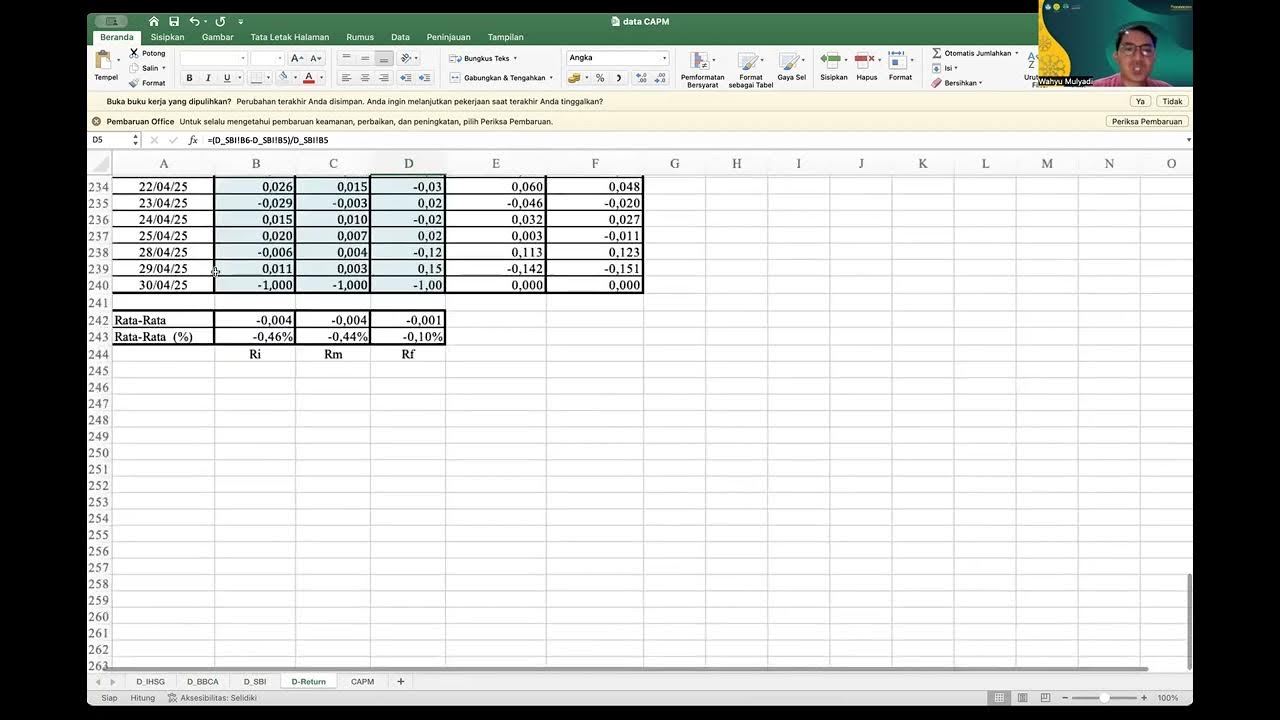CAPM - What is the Capital Asset Pricing Model
Summary
TLDRThis video explains the Capital Asset Pricing Model (CAPM), a tool used to determine the expected return of an investment based on its market risk. The script breaks down the CAPM formula and its components: risk-free rate, beta (a measure of a stock's volatility in relation to the market), and the expected market return. Using real examples like Apple and Facebook, the video demonstrates how to calculate returns and how CAPM can be used in evaluating a company's cost of equity. While CAPM is a popular model, other methods like Arbitrage Pricing Theory are also considered for financial analysis.
Takeaways
- 😀 The Capital Asset Pricing Model (CAPM) shows the relationship between the expected return of an investment and its market risk.
- 😀 CAPM involves three key inputs: the risk-free rate, the asset's beta, and the expected return of the stock market.
- 😀 The risk-free rate is typically represented by the 10-year Treasury note, which is around 3% as of September 2018.
- 😀 Beta measures how an investment moves relative to the overall market; a market beta is always 1.
- 😀 Apple's beta is 0.99, meaning it behaves similarly to the market, moving almost 1% for every 1% market movement.
- 😀 Facebook’s beta is 1.2, meaning it moves 1.2% for every 1% movement in the market, indicating higher volatility than the market.
- 😀 The expected market return used in this example is 9% per year, based on historical averages.
- 😀 In the CAPM formula, the risk-free rate, beta, and market premium (market return minus risk-free rate) are plugged in to estimate the expected return for the asset.
- 😀 Using CAPM, Apple's expected return is calculated as 8.9%, and Facebook's expected return is 10.2%.
- 😀 CAPM can be used to calculate the Weighted Average Cost of Capital (WACC) for a company, which is vital in valuing stocks using discounted cash flow (DCF) analysis.
- 😀 Other models, such as Arbitrage Pricing Theory and multi-factor models, also exist as alternatives to CAPM for calculating discount rates and expected returns.
Q & A
What is the Capital Asset Pricing Model (CAPM)?
-CAPM is an investment theory that shows the relationship between the expected return of an investment and its market risk. It helps investors understand how the return of an asset is affected by market conditions.
What are the three main inputs in the CAPM formula?
-The three main inputs in the CAPM formula are: the risk-free rate, the asset's beta, and the expected return of the market.
What does the risk-free rate represent in CAPM?
-The risk-free rate represents the return an investor can expect from a completely safe investment, often based on the yield of a government bond, such as the 10-year Treasury note.
How does beta affect the CAPM calculation?
-Beta measures the sensitivity of an asset's returns relative to the market's returns. A beta greater than 1 indicates the asset is more volatile than the market, while a beta less than 1 indicates it is less volatile.
What does a beta of 0.99 for Apple stock tell us?
-A beta of 0.99 for Apple means that Apple's stock tends to move in line with the market. If the market moves up or down by 1%, Apple's stock will typically move up or down by 0.99%.
How do you calculate the expected return for an asset using CAPM?
-To calculate the expected return, the formula is: Expected Return = Risk-Free Rate + Beta * (Market Return - Risk-Free Rate). The market premium is the difference between the expected market return and the risk-free rate.
What is the market premium in CAPM?
-The market premium is the difference between the expected return of the market and the risk-free rate. It reflects the additional return an investor expects for taking on the risk of investing in the stock market.
What is the Weighted Average Cost of Capital (WACC) and how does CAPM relate to it?
-WACC is the average rate of return a company is expected to pay to finance its assets, weighted by the proportion of debt and equity. CAPM is used to calculate the cost of equity, which is a component of the WACC.
How does CAPM help in valuing stocks using discounted cash flow?
-CAPM helps in determining the cost of equity, which can then be used as a discount rate to calculate the present value of future cash flows from a stock, giving an estimate of the stock’s intrinsic value.
What other methods can be used to calculate the discount rate besides CAPM?
-Other methods for calculating discount rates include the Arbitrage Pricing Theory (APT) and various multi-factor models, which also take into account multiple risk factors beyond just the market risk.
Outlines

此内容仅限付费用户访问。 请升级后访问。
立即升级Mindmap

此内容仅限付费用户访问。 请升级后访问。
立即升级Keywords

此内容仅限付费用户访问。 请升级后访问。
立即升级Highlights

此内容仅限付费用户访问。 请升级后访问。
立即升级Transcripts

此内容仅限付费用户访问。 请升级后访问。
立即升级浏览更多相关视频

Teori Portofolio dan Analisis Investasi sesi 12 ( Menghitung Capital Aset Pricing Model)

Risk and Return: Capital Asset Pricing Model (CAPM) 【Dr. Deric】

Sharpe ratio, Treynor Ratio, M Squared and Jensens Alpha - Portfolio Risk and Return : Part Two

Penjelasan Tentang Capital Asset Pricing Model

Capital Market Line (CML) vs Security Market Line (SML)

Markowitz Model and Modern Portfolio Theory - Explained
5.0 / 5 (0 votes)
